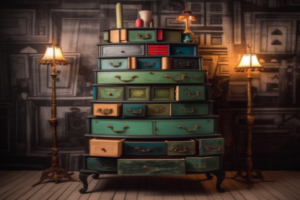Introduction:
Do you have old and worn-out furniture lying around? Instead of throwing them away, consider upcycling! It’s a creative and sustainable way to give new life to your furniture and create unique pieces for your home. Not only does upcycling save money, but it also reduces waste and promotes eco-consciousness. In this guide, we’ll explore various upcycling techniques and ideas to inspire your creativity and help you create stunning furniture pieces that reflect your personal style.
1: Assessing and Preparing Your Furniture:
Before starting an upcycling project, it’s important to evaluate your furniture and prepare it for transformation. Follow these steps:
- Check the structure and functionality: Ensure that the furniture is sturdy and can withstand the upcycling process. Make any necessary repairs or replacements to create a solid foundation.
- Clean and prepare the surface: Give your furniture a thorough cleaning to remove dirt, grime, and old finishes. Sanding the surface will create a smooth base for painting or other transformations.
- Remove hardware and accessories: Take off handles, knobs, or other hardware for cleaning or replacement. This step makes painting or refinishing easier.
2: Painting and Refinishing Techniques:
Painting and refinishing are popular upcycling methods that can give your furniture a fresh and updated look. Consider these techniques:
- Chalk paint: With its matte and vintage-inspired finish, chalk paint is easy to work with and requires minimal prep work. Try different colors and distressing techniques for a shabby-chic or rustic style.
- Spray painting: If you want a smooth and even finish, spray painting is a great option. It works well on metal, plastic, or wood surfaces. Just make sure to work in a well-ventilated area and follow safety guidelines.
- Staining and varnishing: Enhance the natural beauty of wood furniture by staining and varnishing it. Choose from various stain shades and protective varnishes to bring out the grain and color of the wood.
- Decoupage: Get creative with decoupage by adhering decorative paper, fabric, or photographs onto furniture surfaces. This technique offers endless design possibilities and allows you to create a unique and personalized look.
3: Creative Transformations:
Upcycling lets you unleash your creativity and transform furniture in unique ways. Consider these ideas:
- Reupholstering: Give new life to chairs or sofas by reupholstering them with fresh and vibrant fabrics. Mix and match patterns and textures to complement your home decor and create an eclectic look.
- Repurposing: Explore new functions for old furniture pieces. For example, turn an old dresser into a kitchen island or repurpose a vintage suitcase into a stylish side table. Let your imagination guide you to find exciting and unexpected uses for your furniture.
- Adding decorative elements: Use stencils, decals, or hand-painted designs to add decorative touches to your furniture. From intricate patterns to simple motifs, these details can enhance your style and add a personal touch to your pieces.
- Salvaging and combining: Salvage parts from different furniture pieces to create one-of-a-kind items. Combine the legs of an old table with a reclaimed wooden top to craft a unique coffee table. Let your creativity flow as you mix and match different elements.
4: Functional and Storage Solutions:
Upcycling can provide functional and storage solutions for your home. Consider these ideas:
- Shelving units: Convert old ladders, wooden crates, or drawers into unique shelving units. Use them to display books, plants, or decorative items while adding character to your space.
- Storage benches: Transform an old chest or trunk into a storage bench for your entryway or living room. It serves as both seating and a hidden storage space for blankets, shoes, or other items.
- Pegboards and organizers: Attach a pegboard to an old frame or piece of furniture and use it to hang tools, accessories, or kitchen utensils. Repurpose old jars or containers as storage for art supplies, spices, or bathroom essentials.
5: Finishing Touches and Maintenance:
Once your upcycled furniture piece is complete, add the finishing touches and ensure its longevity:
- Hardware and accessories: Clean, polish, or replace hardware such as knobs, handles, or hinges to complement the new look of your furniture. Choose pieces that enhance the overall aesthetic and functionality.
- Protective finishes: Apply a sealant or wax to protect the surface of your upcycled furniture. This will help guard against daily wear and tear, extending its lifespan.
- Regular maintenance: Clean and maintain your upcycled furniture regularly to preserve its appearance and functionality. Follow care instructions based on the materials and finishes used.
Conclusion:
Upcycling your old furniture is not only a sustainable choice but also a chance to showcase your creativity and style. Assess your furniture, prepare it for transformation, and explore painting, refinishing, reupholstering, and repurposing techniques. Let your imagination guide you as you create unique and personalized pieces for your home. Add the finishing touches and maintain your upcycled furniture to ensure its longevity. Embrace the joy of upcycling and enjoy the satisfaction of transforming your old furniture into stunning and environmentally conscious home pieces.







